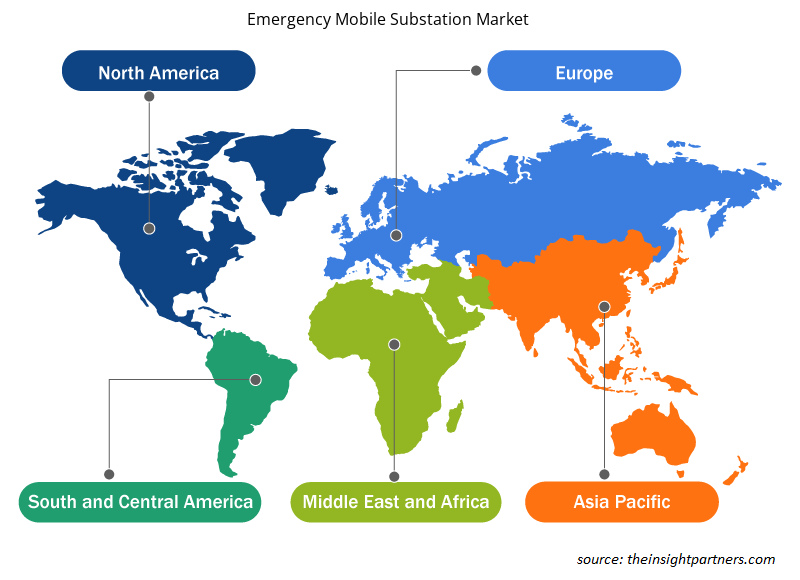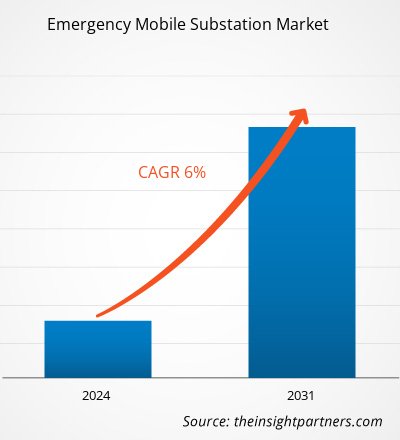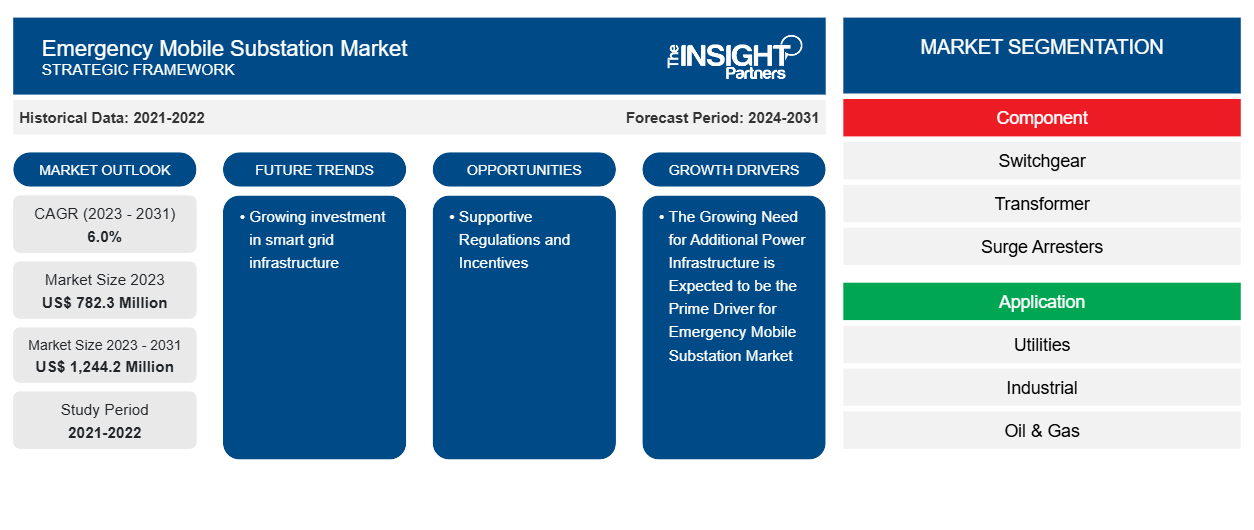Si prevede che la dimensione del mercato delle sottostazioni mobili di emergenza raggiungerà 1.244,2 milioni di dollari entro il 2031, rispetto ai 782,3 milioni di dollari del 2023. Si prevede che il mercato registrerà un CAGR del 6,0% nel 2023-2031. Il mercato delle sottostazioni mobili di emergenza incorpora la fornitura di sottostazioni elettriche trasportabili e complete, progettate principalmente per ripristinare l'alimentazione in circostanze di emergenza o per requisiti di alimentazione temporanei. La crescente richiesta di una fornitura di elettricità costante è uno dei principali motori del mercato.
Analisi di mercato delle sottostazioni mobili di emergenza
La necessità di infrastrutture di energia in surplus è dovuta alla crescente domanda di energia dovuta alla rapida urbanizzazione, alla crescita della popolazione e all'industrializzazione. Al momento della costruzione di nuove sottostazioni o della manutenzione di quelle esistenti, le sottostazioni mobili forniscono un'opzione rapida ed efficace per la distribuzione di energia di emergenza. Inoltre, fornendo energia di backup in caso di guasti alla rete, malfunzionamenti delle apparecchiature e calamità naturali, le sottostazioni mobili sono importanti per stabilizzare la resilienza e l'affidabilità della rete.
Panoramica del mercato delle sottostazioni mobili di emergenza
Rispetto alle sottostazioni convenzionali, che richiedono permessi, progettazione elaborata e procedure di costruzione, le sottostazioni mobili offrono alternative che fanno risparmiare tempo e denaro. Gli sviluppatori di progetti e i fornitori di servizi di pubblica utilità possono distribuire provvisoriamente sottostazioni mobili per soddisfare esigenze di energia temporanee senza i lunghi tempi di consegna associati ai progetti infrastrutturali permanenti. Il mercato delle sottostazioni mobili di emergenza si sta sviluppando a causa della crescente necessità di alimentazione ininterrotta per spazi industriali e commerciali insieme alle crescenti interruzioni di corrente istantanee a livello globale.
Personalizza questo report in base alle tue esigenze
Riceverai la personalizzazione gratuita di qualsiasi report, comprese parti di questo report, o analisi a livello nazionale, pacchetto dati Excel, oltre a usufruire di grandi offerte e sconti per start-up e università
-
Scopri le principali tendenze di mercato in questo rapporto.Questo campione GRATUITO includerà analisi di dati che spaziano dalle tendenze di mercato alle stime e alle previsioni.
Driver e opportunità del mercato delle sottostazioni mobili di emergenza
Si prevede che la crescente necessità di infrastrutture energetiche aggiuntive sarà il motore principale del mercato delle sottostazioni mobili di emergenza
La crescente domanda di energia e la crescente richiesta di forniture energetiche ininterrotte nei settori commerciale e industriale stanno spingendo la domanda di infrastrutture di alimentazione aggiuntive. Le infrastrutture di alimentazione aggiuntive, come le sottostazioni mobili di emergenza, stanno colmando il divario tra domanda e fornitura di elettricità. La crescente necessità di requisiti di elettricità di emergenza e requisiti aggiuntivi di infrastrutture di alimentazione stanno agendo come uno stimolatore di crescita per il mercato delle sottostazioni mobili di emergenza a livello globale.stimulator for the emergency mobile substation market globally.
Regolamenti e incentivi di supporto
La domanda di energia in evoluzione e la crescente attenzione alle energie rinnovabili stanno stimolando il mercato delle sottostazioni mobili di emergenza. I governi di varie economie si stanno concentrando su diverse regole, leggi e incentivi per potenziare l'ammodernamento della rete, la competenza energetica e l'incorporazione di fonti di energia pulita. Come parte importante dei progetti infrastrutturali della rete, gli sviluppatori di progetti e i fornitori di servizi di pubblica utilità hanno diritto a permessi normativi o incentivi monetari per l'implementazione di sottostazioni mobili di emergenza. Pertanto, si prevede che politiche governative di supporto e schemi di incentivi forniranno varie opportunità per il mercato nel periodo di previsione.upgradation, energy competence, and the incorporation of clean energy sources. As a major part of the grid infrastructure projects, project developers and utility service providers are eligible for regulatory permission or monetary incentives for the deployment of emergency mobile substations. Thus, supportive government policies and incentive schemes are anticipated to provide various opportunities for the market over the forecast period.
Analisi della segmentazione del rapporto di mercato delle sottostazioni mobili di emergenza
I segmenti chiave che hanno contribuito alla derivazione dell'analisi di mercato delle sottostazioni mobili di emergenza sono i componenti e la tecnologia.
- In base ai componenti, il mercato delle sottostazioni mobili di emergenza è stato suddiviso in apparecchiature di commutazione , trasformatori, scaricatori di sovratensione e altri. L'apparecchiatura di commutazione ha detenuto una quota di mercato maggiore nel 2023.arresters, and others. The switchgear held a larger market share in 2023.
- In termini di tecnologia, il mercato è stato segmentato in servizi di pubblica utilità, industria, petrolio e gas, metalli e miniere e altri. Il segmento dei servizi di pubblica utilità ha dominato il mercato nel 2023.
Analisi della quota di mercato delle sottostazioni mobili di emergenza per area geografica
L'ambito geografico del rapporto sul mercato delle sottostazioni mobili di emergenza è suddiviso principalmente in cinque regioni: Nord America, Europa, Asia Pacifico, Medio Oriente e Africa e Sud America.
L'Europa ha dominato il mercato delle sottostazioni mobili di emergenza nel 2023. La regione europea comprende Regno Unito, Francia, Italia, Russia e Germania. La rapida industrializzazione e una crescente preferenza per soluzioni di alimentazione avanzate stanno agendo come principali motori del mercato nella regione. Inoltre, si prevede che la crescente adozione della tecnologia smart grid per soddisfare la crescente domanda di elettricità spingerà la crescita del mercato delle sottostazioni mobili di emergenza in Europa nel periodo di previsione.
Approfondimenti regionali sul mercato delle sottostazioni mobili di emergenza
Le tendenze regionali e i fattori che influenzano il mercato delle sottostazioni mobili di emergenza durante il periodo di previsione sono stati ampiamente spiegati dagli analisti di Insight Partners. Questa sezione discute anche i segmenti e la geografia del mercato delle sottostazioni mobili di emergenza in Nord America, Europa, Asia Pacifico, Medio Oriente e Africa e America meridionale e centrale.

- Ottieni i dati specifici regionali per il mercato delle sottostazioni mobili di emergenza
Ambito del rapporto di mercato sulle sottostazioni mobili di emergenza
| Attributo del report | Dettagli |
|---|---|
| Dimensioni del mercato nel 2023 | 782,3 milioni di dollari USA |
| Dimensioni del mercato entro il 2031 | 1.244,2 milioni di dollari USA |
| CAGR globale (2023-2031) | 6,0% |
| Dati storici | 2021-2022 |
| Periodo di previsione | 2024-2031 |
| Segmenti coperti |
Per componente
|
| Regioni e Paesi coperti |
America del Nord
|
| Leader di mercato e profili aziendali chiave |
|
Densità degli attori del mercato: comprendere il suo impatto sulle dinamiche aziendali
Il mercato delle sottostazioni mobili di emergenza sta crescendo rapidamente, spinto dalla crescente domanda degli utenti finali dovuta a fattori quali l'evoluzione delle preferenze dei consumatori, i progressi tecnologici e una maggiore consapevolezza dei vantaggi del prodotto. Con l'aumento della domanda, le aziende stanno ampliando le loro offerte, innovando per soddisfare le esigenze dei consumatori e capitalizzando sulle tendenze emergenti, il che alimenta ulteriormente la crescita del mercato.
La densità degli operatori di mercato si riferisce alla distribuzione di aziende o società che operano in un particolare mercato o settore. Indica quanti concorrenti (operatori di mercato) sono presenti in un dato spazio di mercato in relazione alle sue dimensioni o al valore di mercato totale.
Le principali aziende che operano nel mercato delle sottostazioni mobili di emergenza sono:
- ABB Ltd.
- Società Eaton
- Compagnia elettrica generale
- Siemens AG
- Società per azioni Meidensha
Disclaimer : le aziende elencate sopra non sono classificate secondo un ordine particolare.

- Ottieni una panoramica dei principali attori del mercato delle sottostazioni mobili di emergenza
Notizie e sviluppi recenti sul mercato delle sottostazioni mobili di emergenza
Il mercato delle sottostazioni mobili di emergenza viene valutato raccogliendo dati qualitativi e quantitativi dopo la ricerca primaria e secondaria, che include importanti pubblicazioni aziendali, dati associativi e database. Di seguito è riportato un elenco degli sviluppi nel mercato per il mercato delle sottostazioni mobili di emergenza e delle strategie:
- A dicembre 2023, Siemens AG si è aggiudicata un contratto dal Ministero dell'Elettricità (MoE) della Repubblica dell'Iraq. In base all'accordo, si prevede che Siemens Energy consegnerà cinque sottostazioni ad alta tensione in Iraq. (Fonte: Siemens AG, comunicato stampa/sito Web aziendale/newsletter)
- Nel maggio 2023, Siemens Energy, insieme a Giza Systems, ha distribuito quattro sottostazioni mobili per la società di trasmissione elettrica egiziana di proprietà statale. (Fonte: Siemens AG, comunicato stampa/sito Web aziendale/newsletter)
Copertura e risultati del rapporto sul mercato delle sottostazioni mobili di emergenza
Il rapporto "Dimensioni e previsioni del mercato delle sottostazioni mobili di emergenza (2021-2031)" fornisce un'analisi dettagliata del mercato che copre le seguenti aree:
- Dimensioni e previsioni del mercato a livello globale, regionale e nazionale per tutti i segmenti di mercato chiave coperti dall'ambito
- Dinamiche di mercato come fattori trainanti, vincoli e opportunità chiave
- Principali tendenze future
- Analisi PEST dettagliata
- Analisi di mercato globale e regionale che copre le principali tendenze di mercato, i principali attori, le normative e gli sviluppi recenti del mercato
- Analisi del panorama industriale e della concorrenza che copre la concentrazione del mercato, l'analisi della mappa di calore, i principali attori e gli sviluppi recenti
- Profili aziendali dettagliati con analisi SWOT
- Analisi storica (2 anni), anno base, previsione (7 anni) con CAGR
- Analisi PEST e SWOT
- Valore/volume delle dimensioni del mercato - Globale, Regionale, Nazionale
- Industria e panorama competitivo
- Set di dati Excel
Report recenti
Rapporti correlati
Testimonianze
Motivo dell'acquisto
- Processo decisionale informato
- Comprensione delle dinamiche di mercato
- Analisi competitiva
- Analisi dei clienti
- Previsioni di mercato
- Mitigazione del rischio
- Pianificazione strategica
- Giustificazione degli investimenti
- Identificazione dei mercati emergenti
- Miglioramento delle strategie di marketing
- Aumento dell'efficienza operativa
- Allineamento alle tendenze normative























 Ottieni un campione gratuito per - Mercato delle sottostazioni mobili di emergenza
Ottieni un campione gratuito per - Mercato delle sottostazioni mobili di emergenza